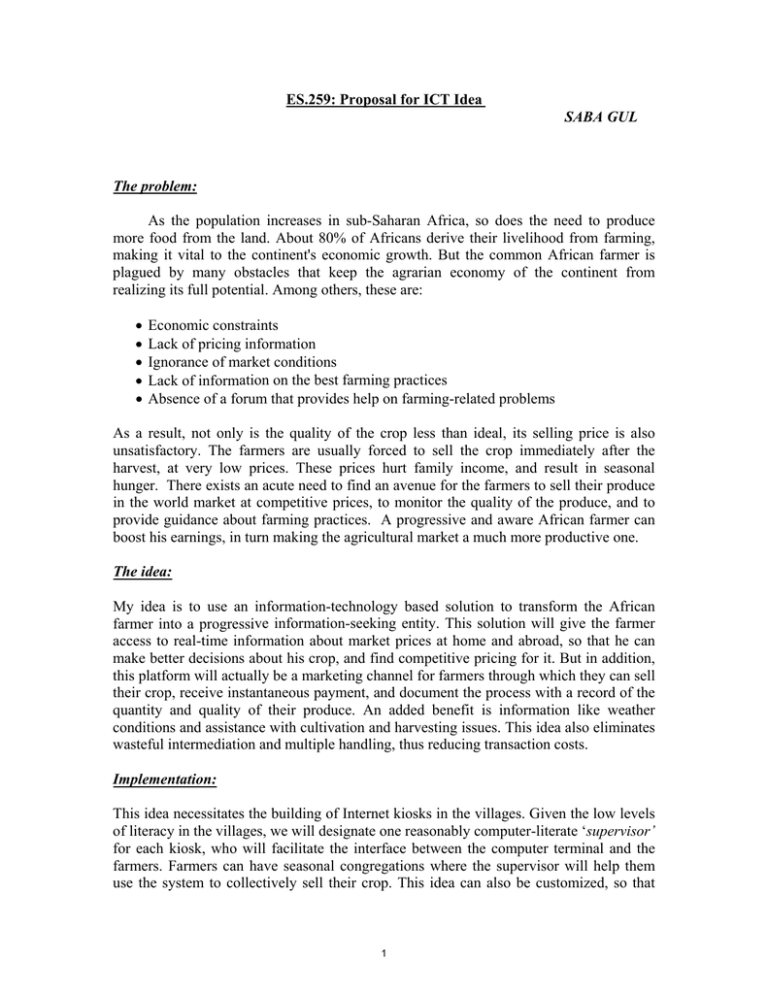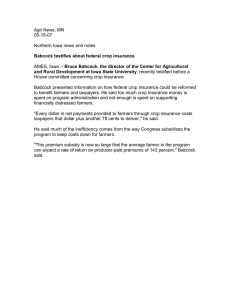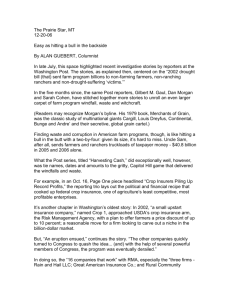As the population increases in sub-Saharan Africa, so does the... more food from the land. About 80% of Africans derive... ES.259: Proposal for ICT Idea
advertisement

ES.259: Proposal for ICT Idea SABA GUL The problem: As the population increases in sub-Saharan Africa, so does the need to produce more food from the land. About 80% of Africans derive their livelihood from farming, making it vital to the continent's economic growth. But the common African farmer is plagued by many obstacles that keep the agrarian economy of the continent from realizing its full potential. Among others, these are: • • • • • Economic constraints Lack of pricing information Ignorance of market conditions Lack of information on the best farming practices Absence of a forum that provides help on farming-related problems As a result, not only is the quality of the crop less than ideal, its selling price is also unsatisfactory. The farmers are usually forced to sell the crop immediately after the harvest, at very low prices. These prices hurt family income, and result in seasonal hunger. There exists an acute need to find an avenue for the farmers to sell their produce in the world market at competitive prices, to monitor the quality of the produce, and to provide guidance about farming practices. A progressive and aware African farmer can boost his earnings, in turn making the agricultural market a much more productive one. The idea: My idea is to use an information-technology based solution to transform the African farmer into a progressive information-seeking entity. This solution will give the farmer access to real-time information about market prices at home and abroad, so that he can make better decisions about his crop, and find competitive pricing for it. But in addition, this platform will actually be a marketing channel for farmers through which they can sell their crop, receive instantaneous payment, and document the process with a record of the quantity and quality of their produce. An added benefit is information like weather conditions and assistance with cultivation and harvesting issues. This idea also eliminates wasteful intermediation and multiple handling, thus reducing transaction costs. Implementation: This idea necessitates the building of Internet kiosks in the villages. Given the low levels of literacy in the villages, we will designate one reasonably computer-literate ‘supervisor’ for each kiosk, who will facilitate the interface between the computer terminal and the farmers. Farmers can have seasonal congregations where the supervisor will help them use the system to collectively sell their crop. This idea can also be customized, so that 1 each farmer can log on to their designated account, order agricultural inputs, get information on best farming practices, find out about prevailing market conditions, prices for their crop, and the weather forecast—all in their local language. This system will act like a virtual market and help-desk for the farmers. Potential Obstacles: Potential obstacles that I see to the implementation of this idea are: • Conversion of huge chunks of data to the farmers’ local language • Method to run internet in at least one spot (the kiosk) in the village • Finding a supervisor in each village • Dealing with the farmers’ hesitation to use computers for farming-related help • Finding online Long-term sustainability issues: Possible issues for long-term sustainability are: • Maintenance of the information available through this platform • Monitoring the feed of real-time information • Sustaining all processes (such as running internet, keeping crop-sale documentatio) involved in the project Funding: The most cost will be incurred in: 1. Setting up the kiosks 2. Making information available on the online forums 3. Educating the supervisor and/or the farmers, As a very rough approximation, I predict the required funding to be in the range of $2000-4000. I am planning to submit this idea to the IDEAS competition, as well as to the PSC for a self-directed summer fellowship. In addition, I am on the lookout for professors who might find this project interesting. Team: A team of 4 to 6 people would be ideal. The nature of the project is such that there are no specific requirements for the team. Timeline: So as not be over-ambitious, I plan to set up this system in only one village, and leave behind an infrastructure and a knowledge base that can be expanded to other villages. • One week to introduce the idea to the farmers, and do a field survey of the village • Two weeks to gather information that will be made available on this platform, and set up connections with online buyers for the crop • Two weeks for setting up the kiosk One week to monitor the running of the system and deal with potential problems 2 MIT OpenCourseWare http://ocw.mit.edu ES.259 Information and Communication Technology in Africa Spring 2006 For information about citing these materials or our Terms of Use, visit: http://ocw.mit.edu/terms.





